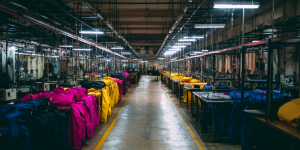
Content Menu
● The Strategic Importance of Fashion Product Prototyping
● The 3 Main Approaches of Prototyping
>> 1. Throwaway (Exploratory) Prototyping
>> 2. Evolutionary Prototyping
● Advanced Techniques in Fashion Product Prototyping
>> 3D Printing and Digital Prototyping
>> Sustainable Materials and Practices
>> Agile Design and Iterative Development
● The Business Case for Fashion Product Prototyping
>> Accelerating Time-to-Market
>> Enhancing Product Quality and Fit
>> Strengthening Supply Chain Collaboration
>> 1. What is the primary purpose of Fashion Product Prototyping?
>> 2. How do the three main approaches differ in practical application?
>> 3. What role does technology play in modern Fashion Product Prototyping?
>> 4. How does prototyping contribute to supply chain efficiency?
>> 5. Why is sustainable prototyping important in today’s fashion industry?
In the dynamic world of fashion, where trends shift rapidly and consumer expectations evolve at breakneck speed, Fashion Product Prototyping has emerged as a cornerstone of successful product development. Brands that master prototyping not only accelerate their time-to-market but also minimize costly errors, optimize supply chain efficiency, and deliver garments that resonate with their target audience. This article explores the three main approaches to prototyping, their application in the fashion industry, and how leveraging these methods can transform your product development pipeline into a powerhouse of innovation and reliability.

Fashion Product Prototyping is more than just a technical step in garment creation; it is a strategic process that bridges creative vision and commercial viability. By building tangible models of new designs, brands can:
– Validate assumptions about fit, comfort, and style.
– Gather actionable feedback from stakeholders and end-users.
– Streamline communication across design, production, and supply chain teams.
– Reduce waste, both in terms of materials and development time.
– Mitigate risks associated with full-scale production launches.
In a globalized market where speed and adaptability are paramount, effective prototyping serves as an insurance policy against expensive mistakes and a launchpad for breakthrough innovation.
Fashion Product Prototyping encompasses several methodologies, but three main approaches dominate the landscape: Throwaway Prototyping, Evolutionary Prototyping, and Incremental Prototyping. Each offers unique advantages and is suited to different stages and objectives within the product development lifecycle.
Definition:
Throwaway prototyping, also known as exploratory or rapid prototyping, involves creating a preliminary version of a product that is meant to be discarded after its purpose is served. The primary goal is to clarify requirements, test radical ideas, or explore complex functionalities without significant investment.
Key Features:
– Speed: Prototypes are built quickly, often using inexpensive materials or digital tools.
– Temporary: These models are not intended to become part of the final product.
– Risk Mitigation: Early identification of design flaws or technical challenges.
– Creative Freedom: Encourages experimentation and out-of-the-box thinking.
Application in Fashion Product Prototyping:
In fashion, throwaway prototyping is ideal for conceptualizing new silhouettes, experimenting with unconventional fabrics, or testing avant-garde construction techniques. For example, a designer may use muslin or digital 3D models to visualize a garment’s drape before committing to costly production runs.
Supply Chain Insight:
By quickly discarding unviable concepts, brands conserve resources and maintain agility in their supply chain, ensuring only the most promising ideas advance to the next stage.
Extended Discussion:
Throwaway prototyping is particularly valuable during the early ideation phase when the design direction is still fluid. It allows design teams to rapidly translate sketches and concepts into physical or digital forms that can be assessed for feasibility. This approach can significantly reduce the risk of investing heavily in designs that may not resonate with the target market or that present unforeseen production challenges. Moreover, throwaway prototypes foster a culture of innovation within fashion houses by encouraging risk-taking without the burden of long-term commitment.
Definition:
Evolutionary prototyping is an iterative process where a basic but functional prototype is continually refined based on feedback. Unlike throwaway prototypes, these models evolve and expand until they meet all user requirements and are ready for production.
Key Features:
– Iterative Refinement: Continuous improvement through multiple feedback cycles.
– Stakeholder Involvement: Regular input from designers, technical teams, and end-users.
– Adaptability: Easily accommodates changing requirements and design tweaks.
– Progressive Development: Demonstrates tangible progress to investors and internal teams.
Application in Fashion Product Prototyping:
This approach is particularly effective for complex garments, such as outerwear or performance apparel, where fit, functionality, and aesthetics must be balanced. Brands use evolutionary prototyping to fine-tune details—adjusting seam placements, testing closures, or integrating smart textiles—until the prototype aligns perfectly with the design brief and consumer expectations.
Supply Chain Insight:
Evolutionary prototyping fosters collaboration between design, sourcing, and manufacturing teams. By involving suppliers early in the process, brands can preempt material constraints and streamline the transition to mass production.
Extended Discussion:
Evolutionary prototyping aligns well with the agile methodologies increasingly adopted in fashion product development. This approach supports a feedback loop where consumer insights, technical feasibility, and aesthetic considerations continuously inform the prototype’s evolution. For example, a brand developing a high-performance jacket might start with a basic shell and progressively add insulation layers, waterproof membranes, and ergonomic features, testing each iteration for performance and consumer appeal. This incremental refinement reduces the risk of costly recalls or redesigns after launch and ensures that the final product is well-optimized for both market demand and manufacturing capabilities.

Definition:
Incremental prototyping divides product development into distinct modules or components, each developed and tested independently before being integrated into the final product.
Key Features:
– Modular Development: Focuses on individual parts or features.
– Testing-Friendly: Simplifies troubleshooting and quality assurance.
– Efficiency: Enables parallel development, reducing overall lead times.
– Complex Project Suitability: Ideal for intricate designs with multiple functional elements.
Application in Fashion Product Prototyping:
In fashion, incremental prototyping is used for multi-component garments or accessories, such as jackets with detachable linings, modular bags, or garments incorporating electronic elements. Each module—be it a sleeve, collar, or embedded sensor—is prototyped and perfected before assembly.
Supply Chain Insight:
This method enhances supply chain flexibility by allowing different teams or suppliers to work on separate modules simultaneously. It also supports just-in-time manufacturing, reducing inventory costs and improving responsiveness to market trends.
Extended Discussion:
Incremental prototyping is particularly advantageous when dealing with complex or tech-integrated fashion products. For example, in wearable technology, the garment’s fabric, electronics, and user interface may be developed by different specialists. By prototyping these components separately, teams can focus on perfecting each aspect without interference. Once the modules meet quality and functionality standards, they are integrated into a cohesive product. This modular approach also facilitates easier updates or customization post-launch, catering to consumer demand for personalization.
The fashion industry is embracing cutting-edge prototyping techniques to stay ahead of the curve and meet evolving consumer demands. These advancements not only improve efficiency but also open new creative and commercial possibilities.
3D printing technology has revolutionized Fashion Product Prototyping by enabling rapid creation of complex structures and intricate details that would be difficult or impossible to achieve with traditional methods. Designers can print prototypes of accessories, shoe soles, or even fabric textures to test aesthetics and functionality. Digital prototyping tools, such as CLO 3D and Browzwear, allow for virtual garment visualization, reducing the need for physical samples and accelerating design iterations.
Sustainability is a growing priority in fashion, and prototyping plays a critical role in minimizing environmental impact. Brands increasingly use recycled fabrics, biodegradable materials, and zero-waste cutting techniques during prototyping to assess their feasibility before mass production. This approach not only reduces waste but also aligns with consumer values and regulatory pressures.
The rise of wearable technology and smart textiles demands sophisticated prototyping methods. Integrating sensors, conductive threads, and microcontrollers into garments requires iterative testing to ensure durability, comfort, and functionality. Prototyping helps identify integration challenges early and facilitates collaboration between fashion designers and technology experts.
Borrowing from software development, agile design breaks down the prototyping process into sprints, each focused on delivering a functional prototype or module. This method enhances responsiveness to market feedback and trend shifts, enabling brands to pivot quickly and maintain competitive advantage.
In fashion, speed is everything. Prototyping allows brands to compress development cycles, react swiftly to emerging trends, and seize first-mover advantage in crowded markets. Rapid prototyping tools and iterative approaches reduce the turnaround time from concept to consumer-ready product.
By identifying issues early, prototyping minimizes expensive post-production fixes and material wastage. Sustainable prototyping practices further enhance cost savings and brand reputation. Efficient prototyping reduces the risk of overproduction and unsold inventory, which are major cost drivers in fashion.
Prototypes provide a platform for rigorous testing of fit, comfort, and durability, ensuring that only the best designs reach consumers. This focus on quality reduces return rates and builds brand loyalty.
Early and frequent prototyping fosters communication between designers, manufacturers, and suppliers, reducing misunderstandings and production delays. Collaborative prototyping also enables better forecasting and inventory management.
Prototyping liberates creative teams to experiment with new materials, technologies, and construction methods, fueling product differentiation and long-term brand growth. It supports a culture of continuous improvement and adaptation.
Fashion Product Prototyping is not just a technical necessity—it is a strategic imperative for brands that want to lead in innovation, quality, and sustainability. By mastering the three main approaches—Throwaway, Evolutionary, and Incremental Prototyping—fashion businesses can accelerate development, optimize their supply chains, and deliver products that delight consumers and stand out in the marketplace.
The integration of advanced prototyping techniques such as 3D printing, sustainable materials, and wearable technology further enhances the value of prototyping, enabling brands to stay agile and competitive in a rapidly evolving industry.
Ready to transform your product development process?
Contact our team of fashion prototyping experts today to discover how we can help you bring your next collection to life—faster, smarter, and more sustainably than ever before.

Fashion Product Prototyping serves to transform design concepts into tangible models, allowing teams to test fit, function, and market appeal before committing to full-scale production. This reduces risk, saves costs, and ensures that the final product meets consumer expectations.
– Throwaway Prototyping is best for early-stage ideation and radical experimentation.
– Evolutionary Prototyping supports continuous refinement based on feedback.
– Incremental Prototyping is ideal for complex, modular products where components can be developed in parallel.
Technology enables rapid prototyping through 3D printing, digital modeling, and integration of smart materials. These advancements speed up development, reduce errors, and open new avenues for innovation in fashion design.
By identifying and resolving design or manufacturing issues early, prototyping streamlines the entire supply chain. It enhances communication, shortens lead times, and reduces the risk of costly production delays.
Sustainable prototyping minimizes environmental impact by using eco-friendly materials and reducing waste. It aligns with consumer values and strengthens brand reputation in a market increasingly focused on ethical production.
Hot tags: Prototyping Approaches in Design, Evolutionary Prototyping Method, Throwaway Prototyping Model, Incremental Prototyping Examples, Rapid Prototyping Process, Software Prototyping Techniques, Design Prototyping Strategies, Agile Prototyping Approach, User Interface Prototyping, Concept to Prototype Workflow